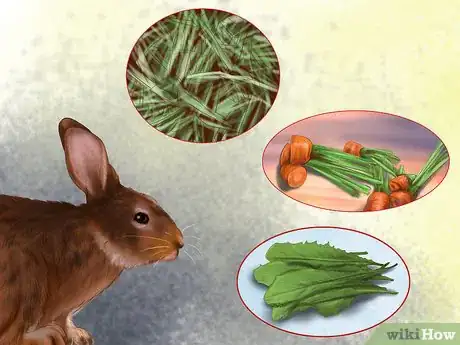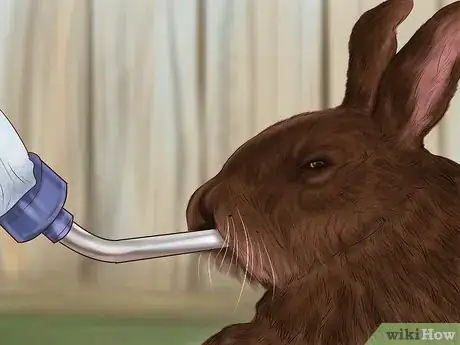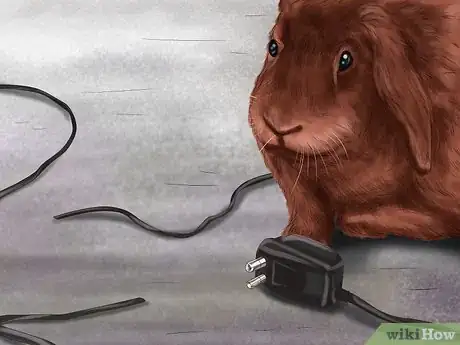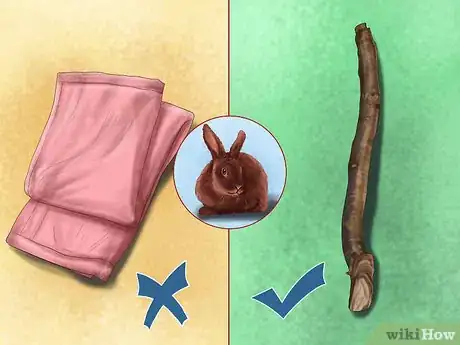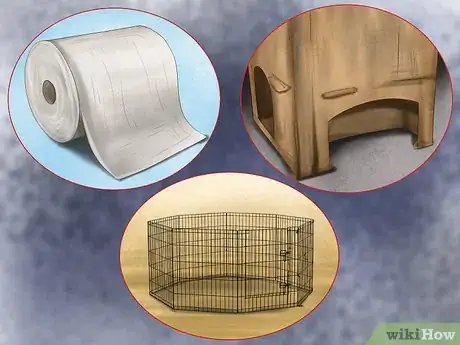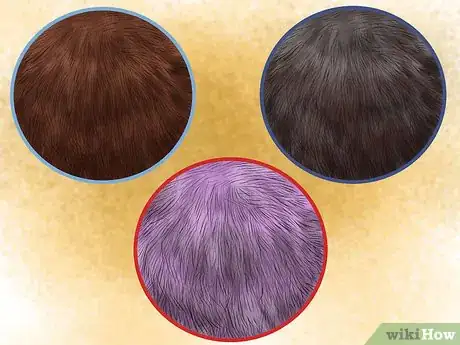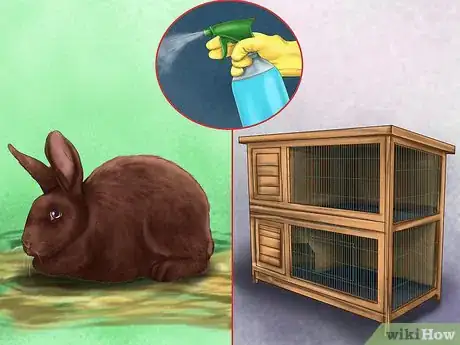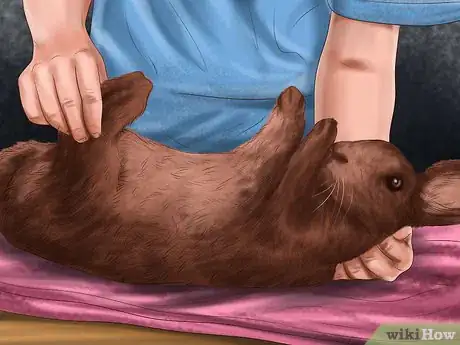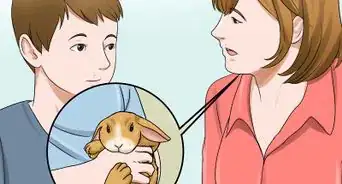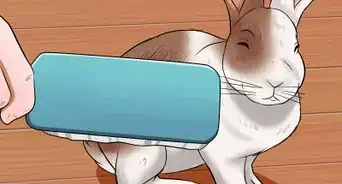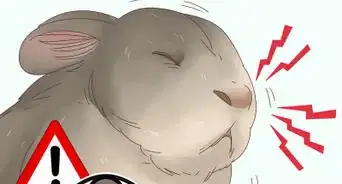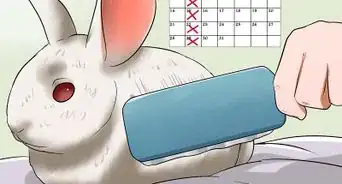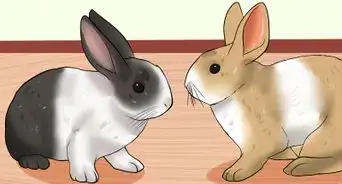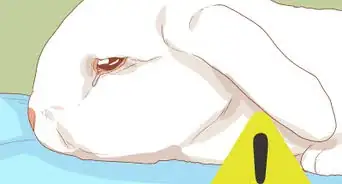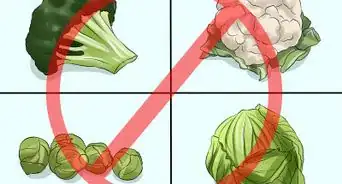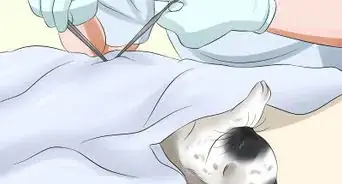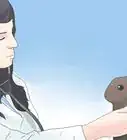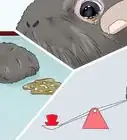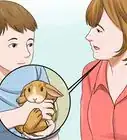This article was co-authored by Pippa Elliott, MRCVS. Dr. Elliott, BVMS, MRCVS is a veterinarian with over 30 years of experience in veterinary surgery and companion animal practice. She graduated from the University of Glasgow in 1987 with a degree in veterinary medicine and surgery. She has worked at the same animal clinic in her hometown for over 20 years.
There are 9 references cited in this article, which can be found at the bottom of the page.
This article has been viewed 29,567 times.
Rabbits are curious, fun, and somewhat mischief prone pets. The Havana rabbit is a medium sized breed of rabbit known for their lush, mink-like fur, which makes them popular with breeders and common as show rabbits. Havana rabbits can live a happy life if you know the right food, environment, and care to give your rabbit.
Steps
Providing the Right Nutrition
-
1Feed her the right food. Your Havana rabbit needs a diet full of fiber to make sure her gut works correctly. The staples of a rabbit's diet should be good quality grass hay, a store bought rabbit pellet food, and fresh green leafy vegetables.
- The amount of pellets you feed your rabbit depends on her weight. She should have 1 ounce of pellets per pound she weights every day. This is then supplemented by hay and fresh vegetables to add fiber to her diet. [1]
- She should also be fed leafy green vegetables three to four times a day, which include carrot tops, dandelion greens, and any type of lettuce except for iceberg, which has no inherent nutrients.[2]
-
2Avoid too many rich foods. Treats can be nice for your Havana rabbit, but you don't want to feed her too many. This can be bad for her system as well as cause unnecessary weight gain. You can feed her a small amount of starchy vegetables, such as carrots and small pieces of fruit, as treats every day.
- For adult rabbits, feed her no more than two tablespoons of fruit per day. Any more can be too much sugars for her system, which can cause gut problems.
- Alfalfa or clover hay are much sweeter than other hay, so feed these to her them as treats in small amounts. They are too rich and contain too much calcium to feed her them in large amounts.
- Never feed your rabbit any other human food other than vegetables and fruit, especially corn or other grains. These can be hard to digest.[3]
Advertisement -
3Keep her hydrated. One of the major components of your rabbit's should be water. She needs hydration to properly digest and process her foods. Make sure you have plenty of fresh, clean water for her every day so she can drink her fill.
- This can be easily done by having an automatic water system, which is made up of a water bottles that hangs on the side of her cage. This will prevent spilling common with water bowls.
- If you use a water bowl, use a heavy, non-plastic bowl that will deter your rabbit from chewing on it.[4]
-
4Prevent obesity. In order to keep your rabbit healthy, you need to make sure she isn't overweight. This can cause heart problems and also make it harder for her to get around. Your Havana should be 4.5 to 6.5 pounds once she reaches maturity around five to six months old.[5]
- Being obese can also impact her fur growth and fur health, which can make it hard for your to groom her and make her uncomfortable.
Preparing Your Home
-
1Secure electrical cables. Havana rabbits love to chew on things because it helps keep their teeth from getting too long.[6] One of the worst things for rabbits are electrical cables. She will chew on them, which is not only bad for your rabbit, it is also bad for you. The cords can cause her health problems as well as mess up many of your electronics.
- In order to stop your rabbit from chewing on cables when you let her roam around your house, wrap each of your electrical cables in hard plastic tubing, which will split down side so you can tuck in the cables. You can also buy spiral ones that will wrap around the cords.[7]
-
2Deter her from chewing on inappropriate objects. When you let your rabbit out in your house to play, you need to watch her carefully. Rabbits love to chew on wood products, which can include the trim around your doors, the edges of your doors, and the legs of your furniture. She may also chew on carpet, wallpaper, sheetrock.[8]
- This is because her teeth need to be filed down enough to avoid cutting into her lip or growing inappropriately.[9]
- To deter her from doing this, give her proper objects to chew on, such as fresh wood branches from willow, aspen, or apple trees.
- You can also get hay, rolled up cotton towels, alfalfa cubes, or fresh pine boards.[10]
-
3Buy the right cage. Your Havana rabbit needs the proper cage to sleep, rest, eat, and play in. It should be sturdy and roomy. There should be enough room for a litter box, food and water dishes, and a roomy box for her to sleep and rest in.
- When you first bring her home, leave her in the cage until she learns to use her litter box.[11]
- You can buy inexpensive wired cages or really nice raised rabbit enclosures. This depends on the amount of space that you have and the amount of money that you want to spend on it
-
4Create an exercise room. Once your rabbit is used to her cage, can use her litter box, and you have rabbit proofed once room in your home, you can let her out on her own to exercise. Make sure she has access to a litter box, water, and food while she plays.
- Bring her cage into the room so she has a comfortable place to run back to.
- You can also buy a dog exercise pen for her to play in.[12]
- You should also give her toys to play with, such as cardboard boxes made into tunnels, toilet paper or paper towel rolls, or boxes stuffed with hay.
Taking Care of Your Rabbit's Fur
-
1Pick the color of fur. There are four different fur varieties of the Havana bunny. The original color and most popular is the chocolate variety. This is the color that gave them their name, since they look like Havana cigars. These rabbits also come in black, blue/lilac, and multi-colored.[13]
- The temperament of the Havana does not depend on the color of the fur, so it is just a personal choice. If you plan to show your rabbit, the chocolate is the most popular in this venue.
-
2Feed her enough protein. Since Havana rabbits are known for their fur, you need to take special care of the things that contribute to her fur health. Protein is an amino acid that contributes to the health of the skin, fur, and blood supply in your rabbit. Because of this, you should feed your rabbit a pellet with a decent amount of protein, which can be between 15 to 18%.
- The rabbit pellet protein will be listed on the label of the food pellet you buy. The first ingredient should be crude protein followed by a combination of crude fat, crude fiber, and other nutrients.
-
3Keep her clean. You need to keep your Havana clean in order to keep her coat as lush as possible. The excrement in her cage should be cleaned out at least once every day to every two days. If you don't, your rabbit may be at risk of flystrike, which is where a fly lays its eggs in her fur and is then bred in her skin.
- This is no necessarily deadly, but it causes major problems for your rabbits health and will leave obvious marks on her skin and fur.
Keeping Your Rabbit Healthy
-
1Have regular checkups. Although your Havana rabbit should be healthy with a proper diet and habitat, she should be taken in once a year to the veterinarian for a check-up. Your vet will give her a physical examination to make sure she is growing properly, is healthy overall, and that her teeth are growing in correctly and aren't too long.
- If her teeth are too long, she may need to have her teeth trimmed by your vet to ensure she can eat correctly and so they won't cause problems.
-
2Spay or neuter your pet. If you are not planning on breeding your rabbit, you should have her spayed (or neutered if your rabbit is male). This should be done when she is four to six months old. This will help prevent unwanted breeding as well as stop aggressive behaviors and prevent cancer or infections in her reproductive system.
-
3Look for common symptoms of sickness. Although you take care of your rabbit, she may get sick. If you notice anything out of the ordinary, you should take her to the vet immediately. Common symptoms to look out for that signal that you rabbit may be sick include:
- Decrease or halt in appetite or water consumption
- Diarrhea
- Lack of defecating for 24 hours
- Discharge from the eyes or nasal passage
- Drooling, which may be a sign of overgrown teeth
- Swelling or reddening of the skin
- Loss of the fur anywhere on her body
- Inability to use her back legs, which makes it difficult for her to hop or move her back legs
- Dark or red urine
- Fever, which is a temperature of more than 105 °F
References
- ↑ http://www.bio.miami.edu/hare/diet.html
- ↑ https://www.wikihow.com/Care-for-Havana-Rabbits
- ↑ http://www.bio.miami.edu/hare/diet.html
- ↑ http://rabbitbreeders.us/feeding-rabbits
- ↑ http://rabbitbreeders.us/havana-rabbits
- ↑ http://rabbit.org/faq-chewing/
- ↑ http://rabbit.org/faq-rabbit-proofing/
- ↑ http://rabbit.org/faq-rabbit-proofing/
- ↑ http://rabbit.org/faq-chewing/
